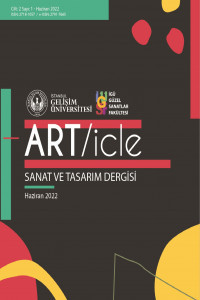Gazi Muhammed Zahireddin Babür Şah’ın (1483-1530) Hatıratı Babür-nâme'de Yer Alan Gastronomi Unsurlarının Değerlendirilmesi
Giriş ve Çalışmanın Amacı: Gastronomi tarihi insanoğlunun beslenme gereksinimleri ile şekillenmiş olup yemek ise biyolojik, sosyal, kültürel, dini, politik ve ekonomik dinamik değişkenlerle bağlantılıdır. Bu çalışma ile Babür Devletinin kurucusu ve tarih sahnesinde önemli bir şahsiyet olan Gazi Muhammed Zahireddin Babür Şah’ın anılarını içeren ve tarihe ışık tutan Babür-nâme eserinde yer almakta olan gastronomi unsurlarının belirlenmesi ve değerlendirilmesi amaçlanmıştır.
Anahtar Kelimeler:
Babür-nâme Babür Şah, gastronomi, mutfak kültürü, gastronomi tarihi
Evaluation of Gastronomy Elements in Babur-name, Memoir of Ghazi Zahīr ud-Dīn Muhammad Babur Shah (1483-1530)
Purpose of the study: The history of gastronomy has been shaped by the nutritional needs of human beings, and food is related to biological, social, cultural, religious, political, and economic dynamic variables. This research aims to identify and evaluate the gastronomic elements in Babur-name's work, which contains the memories of Ghazi Zahīr ud-Dīn Muhammad Babur Shah, the founder of the Mughal State and a historical figure, and sheds light on history.
Keywords:
Babür-nâme, Babur Shah, gastronomy, culinary culture, gastronomy history Babür-nâme Babür Şah, gastronomi, mutfak kültürü, gastronomi tarihi,
___
- ABDYKADYROVA, S., KALYGULOVA, S., BELEKOVA, K., SAGYNDYKOVA, R., ZHEENBEKOVA, G., ISMAILOVA, A., ... & ABDULLAEVA, Z. (2021). Reflection of Intercultural Concepts in the Work “Baburnama”. Open Journal of Modern Linguistics, 11(02), 140.
- ARAT, R.R. (1970). Babürnâme. Milli Eğitim Basım Evi. İstanbul.
- ASLAN, Ü. (2010). Bâbur Divanında Öncelemeler ve Öncelemelerde Paralelizm. Divan Edebiyatı Araştırmaları Dergisi, 4(4), 1-26.
- ATKINS, P., & BOWLER, I. (2016). Food in society: economy, culture, geography. Routledge.
- AYDIN, A. (2017). Bâbürlü Dönemi Fıkıh Çalışmalarının İlk Örneklerinden Biri Olarak Bâbür’ün Mübeyyen Der Fıkh’ı. Usul İslam Araştırmaları, 28(28), 149-182.
- BEGÜM, G. (1987). Hümayunname. Türk Tarih Kurumu Yayınları. Ankara.
- BERBERCAN, M.T. (2010). Türk Dili ve Kültürü Açısından Baburname’de Avcılık. Atatürk Üniversitesi Türkiyat Araştırmaları Enstitüsü Dergisi, 17(42), 11-34.
- BEVERIDGE, A. S. (1921). The Babur-nama in English. Emperor of Hindustan Babur.
- BILKAN, A.F. (1999). Babür’ün Risale-i Validiyye Tercümesi adlı eseri. Bilig, (8), 105-111.
- BUSH, T. (2012). Authenticity in research: Reliability, validity and triangulation. Research methods in educational leadership and management, 75-89.
- COLLINGHAM, L. (2006). Curry: A tale of cooks and conquerors. Oxford University Press.
- DUGHLAT, M. H. (1895). The Tarikh-i Rashidi: A History of the Moghuls of Central Asia; an English Version. Trans. E. Denison Ross. London: Sampson Low, Marston and Co.
- ERALY, A. (2000). Emperors of the Peacock Throne: The Saga of the Great Mughals. Penguin Books India.
- FISHER, M. (2015). A Short History of the Mughal Empire. Bloomsbury Publishing.
- GOLDEN, P. B. (2011). Central Asia in world history. Oxford University Press.
- KILIÇ, M. (2018). Babürname'de Zehir. Zehir (ss. 283-191). İstanbul: Libara Kitap.
- LOVE, P. (2013). Document analysis. In Research in the college context. Routledge.
- MAHAJAN, V. D. (2007). History of medieval India. S. Chand Publishing.
- MASHRABAEVNA, K.R. (2022). " Babur-Name" as A Source of Historical and Ethnographic Science. International Journal on Integrated Education, 5(5), 294-298.
- MUTLU, H., & DOĞAN, M. (2021). A new trend in gastronomy: Culinary medicine chef. International Journal of Gastronomy and Food Science, 24, 100328.
- O'BRIEN, C. (2003). Flavours of Delhi: A food lover's guide. Penguin UK.
- QODIROVNA, T.Z. (2019). Scientific and Theoretical Study of “Baburname” and Its ‘translations into the World Languages. Journal of Critical Reviews, 7(3), 2020.
- RAPLEY, T. (2018). Doing conversation, discourse and document analysis (Vol. 7). Sage.
- SARIIŞIK, M., ÖZBAY G. & CEYLAN, V. (2020). A'dan Z'ye gastronomi sözlüğü. Detay Yayıncılık. Ankara.
- SCHIMMEL, A. (2004). The empire of the great Mughals: History, art and culture. Reaktion Books.
- SINGH, N.G.K. (2017). Babarvani and the call for gender justice. Sikh Formations, 13(1-2), 5-19.
- STANDAGE, T. (2009). An edible history of humanity. Bloomsbury Publishing USA.
- TOUSSAINT-SAMAT, M. (2009). A history of food. John Wiley & Sons.
- ÜNLÜ, S. (2013). Harezm Altınordu Türkçesi Sözlüğü. Eğitim Yayınevi.
- ÜNLÜ, S. (2014). Çağatay Türkçesi Sözlüğü. Eğitim Yayınevi.
- YURDAKÖK, M. (2007). Bâbür Şah’ın (1483-1530) ünlü eseri Babürname’de tıbbî bilgiler. Çocuk Sağlığı ve Hastalıkları Dergisi, 50-73.
- Türk Dil Kurumu (TDK). (2019). Türk Dil Kurumu Sözlükleri. Erişim tarihi. 17.11.2022, https://sozluk.gov.tr/
- ISSN: 2718-1057
- Yayın Aralığı: Yılda 2 Sayı
- Başlangıç: 2020
- Yayıncı: İstanbul Gelişim Üniversitesi
